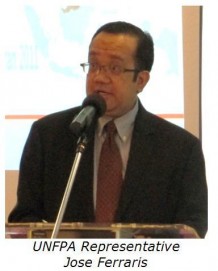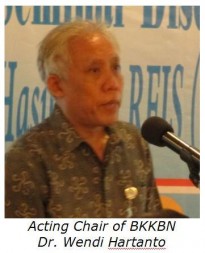JAKARTA, Indonesia: The Resource Flow Indonesia Study for 2011 Fiscal Year (2011 RFIS) is part of the broader Resource Flow project, a joint collaboration between the United Nations Population Fund (UNFPA) and the Netherlands Interdisciplinary Demographic Institute (NIDI). The project tracks national and international financial resource flows, the amount received and the domestic expenditure on population programmes.
The Resource Flow study is vital for the implementation of the 1994 International Conference for Population and Development (ICPD) principles. The 1994 ICPD principles promote sustainable development through human rights-based, gender-sensitive development programmes, specifically on RH, FP, STI/HIV/AIDS, and population research and data. The RFIS project is also conducted to ensure transparency and accountability of population-related development programmes at national, provincial and district level, which are implemented by the government and NGOs.
The 2011 RFIS was conducted in September 2012 – January 2013 by the Demographic Institute-Faculty of Economics, University of Indonesia, commissioned by the United Nations Population Fund (UNFPA).

“The findings of the resource flows analysis can be used in advocacy, to inform policy, and influence direction of future population activities,” said UNFPA Representative Mr. Jose Ferraris.
According to the study, the estimated revenue for funding population-related programmes in 2011 reached Rp. 6.4 trillion, an increase of 8 percent from 2010 revenue at Rp. 5.9 trillion.
The 2011 RFIS reports that 98.7 percent of the revenue went to the government with 40.7 percent channeled to the Ministry of Home Affairs, 40.1 percent to the National Population and Family Planning Board (BKKBN), and 16.5 percent to the Ministry of Health. BPS Statistics Indonesia received only 0.2 percent and the Ministry of Environment received the least at 0.02 percent.
The remaining 1.3 percent went to non-governmental organizations (NGOs) with 86.4 percent channeled to the Indonesian Planned Parenthood Association (PKBI), 4.6 percent to the National Commission for Older People and 4.1 percent to the Center for Population and Policy Studies at Yogyakarta-based University of Gajah Mada.
The sources of the government’s revenue are the government’s own contribution (83 percent) and donors (17 percent). While for NGOs’ revenue, the majority (62.3 percent) came from domestic and various other sources.
Looking at expenditures, the 2011 RFIS reports that revenue was spent on programmes and activities which included: male involvement, service delivery, commodity provision, research, piloting projects, advocacy and information-education-communication. These are conducted under reproductive health (RH), family planning (FP), HIV-AIDS and population research and data programmes.
The findings reveal a tendency for role division between the government and the NGOs. The government focused more on promoting population issues through information-education-communication (IEC) and advocacy, while the NGOs concentrated more on conducting research, provision of commodity and piloting projects.

The 2011 RFIS show that population resource channeled to the province amounted Rp 598 billion and to the district Rp 22.2 billion. This study is the only one so far that has looked at this disaggregation of resource allocation.
More resources from both international and national sources are needed to provide adequate funding for RH, FP, HIV-AIDS, and population data and research. The Rp. 6.4 trillion in 2011 revenue is still too meager given Indonesia’s large reproductive age population, around 142.5 million people, consisting of 71.6 million women and 70.9 million men (2010 Population Census).
“Given the strategic role of population for development and the current socio-economic and political trends, revitalizing national FP and population programme are urgent,” said Dr. Wendi Hartanto as acting chairperson of the BKKBN.
The urgency is apparent in recent data. According to the preliminary result of the 2012 Indonesia Demographic and Health Survey (IDHS 2012), contraceptive use in 2012 is 61 percent, only a 1 percent increase from 60 percent in 2007. The unmet need for family planning is high at 11 percent, as reported by IDHS 2012. Around 12 percent of births are miss-timed and 7.4 percent are unwanted (IDHS 2007). Awareness on HIV/AIDS prevention among 12-24 year old population is still limited, as is access to antiretroviral treatment. As indicated by the 2010 Population Census, there is a tendency to get married younger. Funding for population research and data collection and analysis is crucial for well-targeted programmes that answer the needs of individuals.

